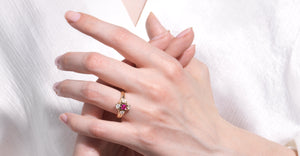How Can I Tell If My Ruby Ring Is Authentic
Jul 11, 2025
by Suzanne Sachs • 5 min read

THE BASICS --
A ruby’s rich color and timeless appeal make it one of the most sought-after gemstones—but how can you tell if a ruby is real? From checking for natural inclusions to evaluating its hardness and hue, there are several key indicators gemologists use to identify a genuine ruby. Understanding these traits can help you confidently assess your ruby, whether you're buying it or verifying an heirloom.
WHAT YOU NEED TO KNOW--
In this guide we will explain the following:
- Start with a Trusted Source
- Look for Inclusions and Test for Hardness
- Pay Attention to Ruby Color
- Consider the Era and Design Style
- Request a Gemological Certificate
- Evaluate the Seller's Other Pieces
- Check the Chain Of Ownership
- Why Ruby Authenticity Matters
- If Your Ring Isn't Natural
Start with a Trusted Source
The most reliable way to confirm a ruby’s authenticity is to buy from a reputable jeweler who specializes in fine gemstones. A knowledgeable seller will typically evaluate the stone’s origin, quality, and whether it’s natural or lab-created—and may also provide a gemological certificate.
Of course, not all rubies come from traditional retailers. Yours might be a family heirloom, a unique find from an estate sale, or a gift with unknown origins. Fortunately, there are still ways to determine whether the ruby is real, and to understand more about its quality and history.
1. Look for Inclusions and Test for Hardness
One of the clearest indicators of a natural ruby is the presence of internal inclusions. Silk-like inclusions—fine, thread-like patterns—are especially common in Burmese rubies and can help confirm a ruby’s natural origin. While inclusions may seem like imperfections, they’re actually a sign the stone is real. In contrast, rubies that appear flawless under magnification are often synthetic.
One simple but effective way to check if your ruby is real is to test its hardness. Natural rubies are extremely durable, ranking 9 on the Mohs scale—just below diamonds—so they should resist scratching from most materials. Ask your jeweler to perform a professional hardness test using the appropriate tools. If the stone scratches too easily or shows signs of wear inconsistent with ruby’s toughness, it may be synthetic or a different gemstone altogether.
2. Pay Attention to Ruby Color
Color can reveal a lot about a ruby’s authenticity and origin. Natural Burmese rubies are prized for their vivid “pigeon blood” hue—a rich, pure red often with a slight bluish fluorescence. Some may even show pinkish tones in certain lighting. In contrast, Siam rubies from Thailand typically have a darker red appearance with brownish or blackish undertones. Recognizing these subtle color differences can help you determine if your ruby is natural, synthetic, or possibly treated. you identify whether your ruby is natural, synthetic, or from a specific origin.
2. Consider the Era and Design Style
The design and materials used in your ring can provide important clues about your ruby’s authenticity. In the Georgian era, red zircon was often used as a ruby substitute due to its bold color. During the Victorian period, red spinel became a popular alternative for its affordability and deep hue. By the 1920s, synthetic rubies were widely used in jewelry, offering intense color without the natural inclusions seen in untreated stones. Mid-century pieces from the 1960s to 1980s often featured both lab-created and natural rubies in dramatic, modern designs. Recognizing these trends can help you better understand the likely origin and authenticity of your ruby ring.
3. Request a Gemological Certificate
One of the most reliable ways to confirm whether a ruby is natural or synthetic is to obtain a gemological certificate from a trusted lab such as GIA, AGL, or AGI. These certificates provide detailed information about the ruby’s origin, treatments (if any), and authenticity. A certified report not only gives you peace of mind but also adds value to your ring should you ever wish to insure, appraise, or sell it in the future.
3. Evaluate the Seller’s Other Pieces
If your ruby ring came from a jeweler or dealer, take a closer look at the rest of their collection. Even if your specific ring doesn’t come with documentation, verified rubies with similar traits can help support its authenticity. A seller who offers natural rubies backed by lab reports or provenance details is more likely to be reputable. Always check their credentials and reviews to confirm they specialize in genuine, high-quality gemstones.
4. Check the Chain of Ownership
Whenever possible, try to trace the ruby ring’s ownership history. Knowing whether it came from a family heirloom, estate collection, or reputable jeweler can offer meaningful clues about its authenticity. Look for any documentation of repairs, appraisals, or provenance that might help identify when and where the ruby was purchased, and whether it’s a natural or synthetic stone.
Why Ruby Authenticity Matters
Taking the time to verify your ruby’s authenticity is well worth the effort. Confirming that it’s a natural, untreated stone helps ensure you’re paying a fair price and receiving the quality you expect. Authenticity also plays a key role in insurance, resale value, and the sentimental significance of the ring—especially if you plan to pass it down as an heirloom.
If Your Ruby Isn't Natural
Discovering that your ruby is synthetic or heavily treated can be disappointing—but it doesn’t take away from its sentimental value. Understanding the stone’s background and how to care for it properly ensures it remains a meaningful part of your collection. You might choose to replace the stone with a verified natural or antique ruby, or reset the ring into a design that better reflects your personal style.
Once you know the truth about your ruby, you can appreciate the story it tells, no matter when that story began or how it came to be part of your romance.
SUZANNE SACHS
Press Love:
Contact Suzanne
If you love vintage jewelry please feel free to contact Suzanne or browse our collection of vintage engagment rings.










